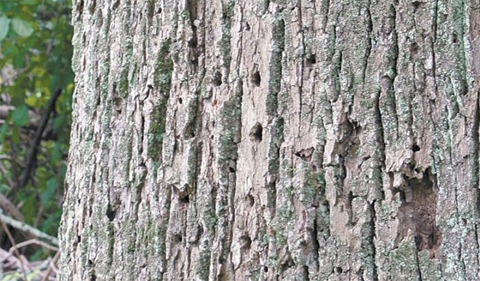By Kevin Knavish
Environmental and Plant Biology Student interning at the Wayne National Forest
The Emerald Ash Borer, Agrilus planipennis, is a bright metallic-green beetle native to Asia that grows to be a half inch long. After being discovered in the Detroit area in 2002, the species is believed to have migrated to North America inside of wooden packaging materials.
Agrilus planipennis is a member of the Buprestidae family. The Buprestidae family consists of flat-headed, metallic, wood-boring beetles, and they also are commonly classified as the jewel beetles. The emerald ash borer typically passes one generation per year, with each female laying from 50 to 90 eggs. Larvae feed in the cambium of trees until they become adults, at which time they emerge to feed on the ash foliage, leaving a D-shaped exit hole in the bark. Emerald Ash Borers have killed tens of millions of trees in the United States and Canada, with infestations observed on Wayne National Forest.
Agrilus planipennis has been recorded using several Fraxinus species, ash trees, as hosts in Eastern Asia, such as Fraxinus chinensis, Fraxinus lanuginose, and Fraxinus mandshurica. While the beetles do not create an ecological abnormality in its native region, in North America, the borers are invasive and can kill large numbers of ash trees, particularly the species Fraxinus americana, Fraxinus pennsylvanica, and Fraxinus nigra. Fringe trees, Chionanthus virginicus, have also been targeted, and experts believe that the problematic herbivory will continue to spread to other species.
In China, Agrilus planipennis combats natural parasitoids, primarily non-stinging wasps like Oobius agrili, Tetrastichus planipennisi, and Spathius agrili. Without these parasitoids, the Emerald Ash Borer population has grown out of control. The USDA APHIS (Animal and Plant Health Inspection) organization has begun to release these three species of wasp to combat the borers in Southern Michigan. Oobius agrili also has been released in Ontario. In North America, woodpeckers eat Agrilus planipennis larvae, and heavy woodpecker damage to a tree can be a sign of infestation.
Insecticides have been used to combat the beetle but have never reached 100 percent mortality. In greenhouse experiments, the fungus Beauveria bassiana demonstrated lethal effects, particularly the infection of the beetles with white muscadine disease. When insects come into contact with the fungus’ spores, the spores germinate in the skin and body of the host. When the fungus was introduced on the foliage and trunks of ash trees, Agrilus planipennis populations decreased in both recently colonized areas, as well as areas with established problems with the pest.
Movement of firewood over states lines, as well as movement of ash material from infected areas, is regulated to prevent the spread of the beetle. In Michigan, sale and transport of nursery-grown ash trees is prohibited.
Works Cited
Bartlett, Troy. “Family Buprestidae – Metallic Wood-Boring Beetles.” Stick Bug – Anisomorpha Buprestoides – BugGuide.Net, 16 Feb. 2004, bugguide.net/node/view/162.
“Chinese Parasitic Wasp Let Loose to Kill Emerald Ash Borer Eggs | CBC News.” CBCnews, CBC/Radio Canada, 9 Aug. 2015, www.cbc.ca/news/canada/ottawa/oobius-agrili-parasitic-wasp-introduced-to-ontario-to-fight-emerald-ash-borer-1.3183918.
“City of Logmont Colorado.” City of Logmont Colorado, 2018, www.longmontcolorado.gov/departments/departments-e-m/forestry/emerald-ash-borer.
Duan, Jian J, et al. “Biology and Life History of Tetrastichus Planipennisi (Hymenoptera: Eulophidae), a Larval Endoparasitoid of the Emerald Ash Borer (Coleoptera: Buprestidae).” BioOne, www.bioone.org/doi/full/10.1653/024.094.0430.
“Emerald Ash Borer.” Emerald Ash Borer – The Arbor Day Foundation, www.arborday.org/trees/health/pests/emerald-ash-borer.cfm.
Groden, Emily, et al. “Using Beauveria Bassiana for Insect Management.” University of Conneticut, http://ipm.uconn.edu/documents/raw2/Using%20Beauveria%20Bassiana%20for%20Insect%20Management/Using%20Beauveria%20Bassiana%20for%20Insect%20Management.php?display=print
Hannah, Jim. “Attack on white fringetree by emerald ash borer likely to be widespread.” Wright State University, Phys.org. 22 July. 2015, https://phys.org/news/2015-07-white-fringetree-emerald-ash-borer.html
Kenis, Marc. “Agrilus Planipennis (Emerald Ash Borer).” Diseases Caused by Phages., Singapore Botanic Gardens, 18 Sept. 2009, www.cabi.org/isc/datasheet/3780.
Matsoukis, Christian. “Emerald Ash Borer Information Network.” Emerald Ash Borer | About Emerald Ash Borer (EAB), www.emeraldashborer.info/.
Ross, Jeannette. “The Wilton Bulletin.” The Wilton Bulletin, HAN Network, 2018, www.wiltonbulletin.com/103865/ash-trees-victims-of-emerald-ash-borer-damage/.




















Comments